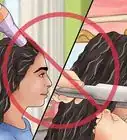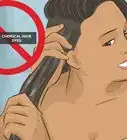This article was co-authored by Laura Martin. Laura Martin is a Licensed Cosmetologist in Georgia. She has been a hair stylist since 2007 and a cosmetology teacher since 2013.
There are 9 references cited in this article, which can be found at the bottom of the page.
This article has been viewed 411,116 times.
Senegalese twists are a popular protective hairstyle for Afro-textured hair sported by many trendy, chic women. The look can be created with hair extensions and is easier to do than microbraids, cornrows, and many other braided hairstyles. It takes up to 6 hours to do twists, but they can last 2 to 3 months if well cared for. With practice and the right supplies, you can do Senegalese twists on your own or with a friend.[1]
Steps
Preparing Your Hair
-
1Determine if your hair is long enough. If your natural hair is about 0.75 in (1.9 cm) or longer, you can create Senegalese twists.[2] Senegalese twists work with either natural or relaxed hair; in either case, you will have to use synthetic hair extensions.
-
2Decide on a type of extension. A couple of popular types of synthetic hair extensions to use for this style are the ones labeled Kanekalon (silky braiding hair) and Toyokalon (yaki braiding hair).[3]Advertisement
-
3Separate and trim the strands. Open the package of extensions and separate the strands of braiding hair, if woven together, by gently rubbing them between your fingers. Separate the extensions into sections based on how wide you want your twists to be. Then, fold each section in half so that it forms a “U” shape. The bend is the point at which the extension section will be added to your real hair, while the two ends will be woven into the twists.
- Proceed to trim the strands to your desired length using salon scissors.
-
4Wash, detangle, and dry your hair. Wash your hair with your regular shampoo and conditioner. Detangle it using a wide-tooth comb and a detangling spray. Dry your hair naturally or with round, natural-bristle brush and a blow dryer on a low heat setting. This will straighten and stretch the hair before you braid it.[6]
- Do not use any hair oil. You need your hair to be straight (but not slippery) in order for it to coil correctly. However, you may want to use a heat protectant product on your hair before you blow dry it.
Creating Senegalese Twists
-
1Part your hair as desired. It is best to do this before separating sections of hair, as the part you create will stay put once you do the twists, and trying to adjust it afterward can be difficult.
-
2Separate your hair into quadrants and then divide those sections. Use comb to divide your hair into 4 even sections. Then, divide each section into 4 sections. Each of these sections should be 1 inch (2.5 cm) or less in width. However, you might need to divide each section into halves or quarters if you have very thick hair.
- Comb the section of hair out to remove any tangles.
- Use small hair clips to keep the rest of your hair away from your fingers as you work on each particular section.
-
3Split the section of hair into 2 sub-sections. Use a comb or your fingers to carefully divide the section up into 2 halves of equal width.
- Do your best to completely separate the 2 smaller sections. You do not necessarily need to comb them out again, but each section should appear straight, and the 2 should not be joined together at any point.
-
4Twist each section to the right. Use your fingers to gradually twist each smaller section to the right. Continue twisting until each section has been begun to twist into a coil.
- Grab each section 1 to 2 in (2.5 to 5.1 cm) from the scalp and twist from that point.
- The 2 sections should be evenly twisted.
-
5Twist in extension hair. Lay the center of a prepared piece of synthetic extension hair over the 2 sections of real hair before you begin twisting and coiling them. Bend the extension hair so that the center remains in between the 2 split halves of real hair. The ends of the extension should drape over the 2 sections of real hair already separated out.[7]
- Follow the same procedure used for real hair to twist the extension hair in. Grab both your real hair and the extension hair in between your fingers and twist to the right until it coils. This way, you secure the extension hair in place and weave it into your natural hair seamlessly.
-
6Wrap the coiled strands around each other. Overlap the right-hand section of hair over the left-hand section once, and then twist the right-hand and left-hand sections so they are going in the same direction. Next, wrap the twisted sections around each other going in opposite directions. The right-hand section should be wrapping clockwise while the left-hand section is wrapping counter-clockwise. Coil the combined strands of hair to the right, bringing the overlapping section under and back up once more.
- From this point on, you should continue to twist and coil the hair in this manner, working over and under from the right, until you reach the end of the 2 combined sections.
- If done correctly, the twist should be tight enough and even enough to stay in place for a little while without being sealed immediately.
-
7Repeat the procedure with the rest of your hair. Separate your remaining hair into similarly sized sections, working on 1 section at a time.
- Each section of hair must be roughly the same size as the other sections. Otherwise, your Senegalese twists may look uneven when finished.
- Similarly, you should use the same amount of extension hair for each twist.
-
8Seal the ends in boiling water. Doing so will hold the Senegalese twists in place for a long-term style.
- Bring a small saucepan of water to boil over medium-high heat. Once it reaches a steady boil, remove the pan from the heat completely.
- Carefully dunk the bottom ends of each twist into the hot water. Submerge each twist so that all the loose ends are covered. Leave each end in water for 15 seconds.
- If doing Senegalese twists on smoother hair, you might need to gently knot the ends before sealing them in hot water or use hair elastics to tie them off.
- Allow hair to dry naturally.
-
9Treat the ends with oil. It is recommended to dip the ends in olive oil or Jamaican castor oil after the water dries so as to lock moisture into the ends, preventing them from drying out. Allow to dry naturally once more.
Caring for Senegalese Twists
-
1Wash the twists once a week. You should only wash Senegalese twists once a week. Use shampoo diluted with equal parts water.
- If you wash your hair more frequently, you could cause the twists to unravel faster.
-
2Apply light oil on your scalp a few times during the week. 2 to 3 times a week is ideal. Doing this will help hydrate your scalp.
- Peppermint, coconut, or Jamaican Black Castor Oil (JBCO) are examples of oils you could use.
-
3Spray liquid leave-in conditioner on your braids daily. Braid spray or liquid conditioner can keep your hair moisturized and healthy. In order to promote optimal hair health, you should use it once a day.
- Avoid creamy conditioners while the braids are in place. Creamy conditioners can leave residue and build-up, and this, in turn, can create knots along the base of your twists.
- For an all-in-one option for both your hair and your scalp, mix a little coconut oil, JBCO oil, and conditioner into a spray bottle of water. Apply this solution to both your scalp and hair daily, and skip a separate oil treatment for your scalp.
-
4Tie a silk or satin scarf around your braids before sleeping. Pull the twists back in a ponytail and tie a scarf made from a smooth material around your hair to protect them during the night.[8]
Expert Q&A
Did you know you can get expert answers for this article?
Unlock expert answers by supporting wikiHow
-
QuestionHow long should it take to do Senegalese twist?
 Laura MartinLaura Martin is a Licensed Cosmetologist in Georgia. She has been a hair stylist since 2007 and a cosmetology teacher since 2013.
Laura MartinLaura Martin is a Licensed Cosmetologist in Georgia. She has been a hair stylist since 2007 and a cosmetology teacher since 2013.
Professional Hair Stylist
-
QuestionWhat is a flat twist?
 Laura MartinLaura Martin is a Licensed Cosmetologist in Georgia. She has been a hair stylist since 2007 and a cosmetology teacher since 2013.
Laura MartinLaura Martin is a Licensed Cosmetologist in Georgia. She has been a hair stylist since 2007 and a cosmetology teacher since 2013.
Professional Hair Stylist
-
QuestionHow long does it take to do your own box braids?
 Laura MartinLaura Martin is a Licensed Cosmetologist in Georgia. She has been a hair stylist since 2007 and a cosmetology teacher since 2013.
Laura MartinLaura Martin is a Licensed Cosmetologist in Georgia. She has been a hair stylist since 2007 and a cosmetology teacher since 2013.
Professional Hair Stylist
Things You'll Need
- Rattail comb
- Small hair clips
- Synthetic hair extensions (optional)
- Saucepan
- Hair oil
- Silk or satin scarf
- Spray bottle
References
- ↑ https://www.youtube.com/watch?v=5iPkQsZQUbA
- ↑ http://www.naturalhairmag.com/senegalese-twists-101/
- ↑ http://www.naturalhairrules.com/senegalese-twist/
- ↑ http://un-ruly.com/marley-vs-kanekalon-havana-senegalese-twists-braids/#.V6NzR1dEzBI
- ↑ http://un-ruly.com/marley-vs-kanekalon-havana-senegalese-twists-braids/#.V5-8rVdlnBI
- ↑ https://www.youtube.com/watch?v=09tmyrlH0JA
- ↑ http://www.kyssmyhair.com/the-difference-between-senegalese-havana-and-kinky-twists/#.Ujt5g8Z6bYI
- ↑ https://www.youtube.com/watch?v=DBN_JdSozSI
- Videos provided by Abbyliciouz Channel
About This Article
To do Senegalese twists, start by washing, detangling, and drying your hair. Next, use a comb to divide your hair into 4 even sections, then divide each section into 4 sections. Twist each section to the right until it begins to twist into a coil, then twist in the extension hair and wrap the coiled strands around each other. Repeat the procedure with the rest of your hair and seal the ends in boiling water. For tips on maintaining for your new look, read on!
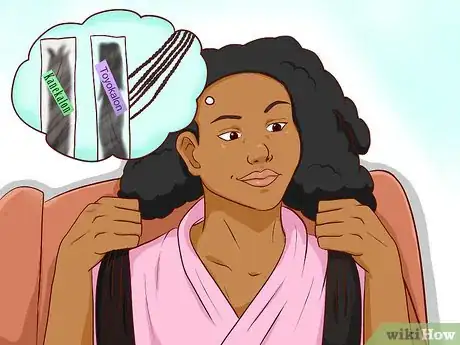
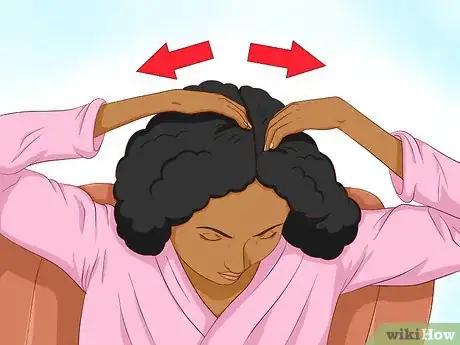

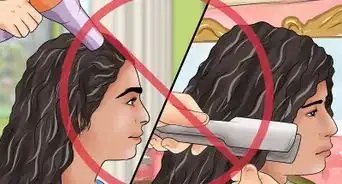







-Step-20.webp)















